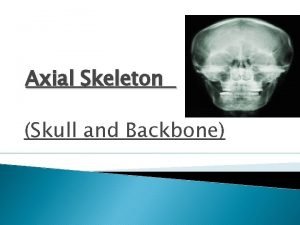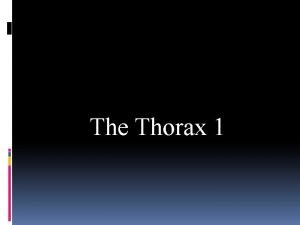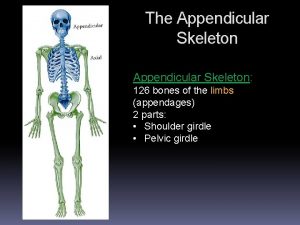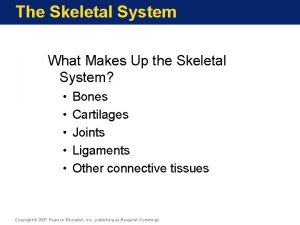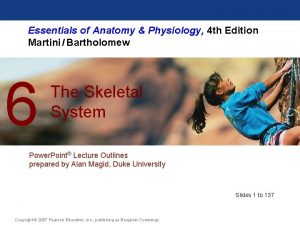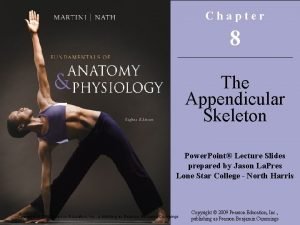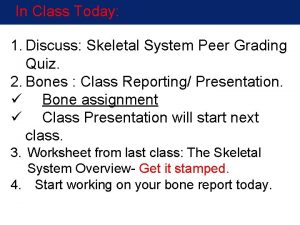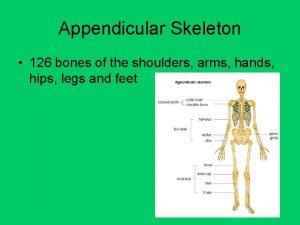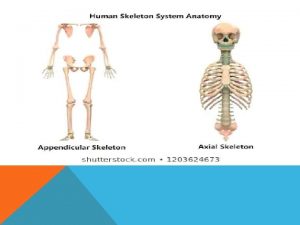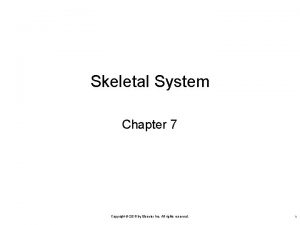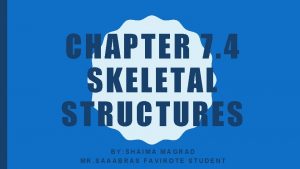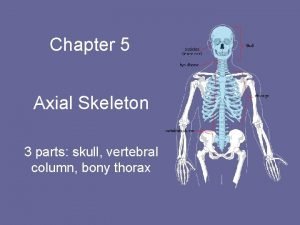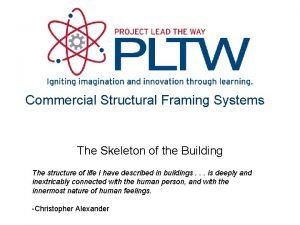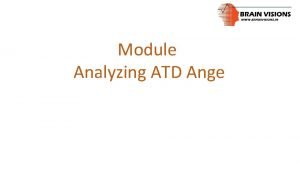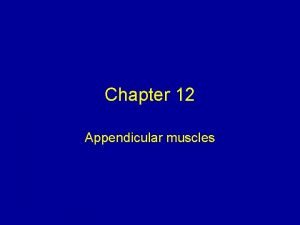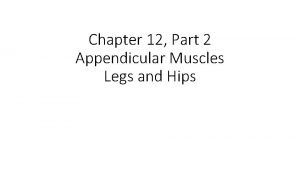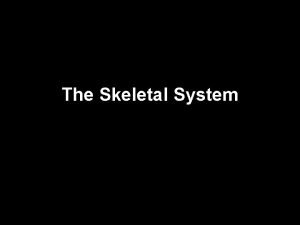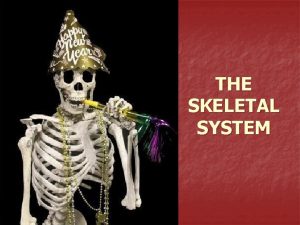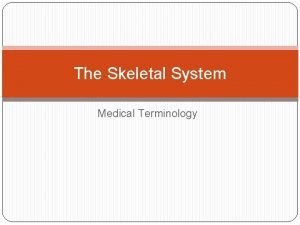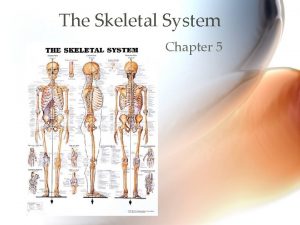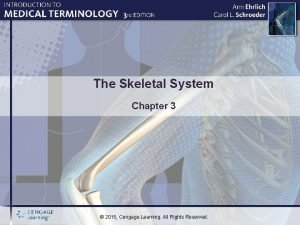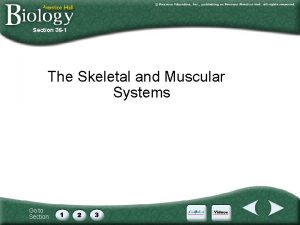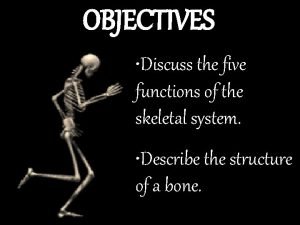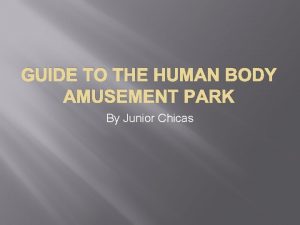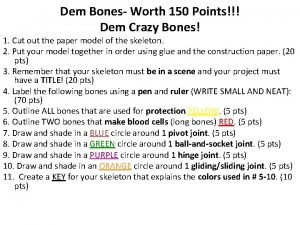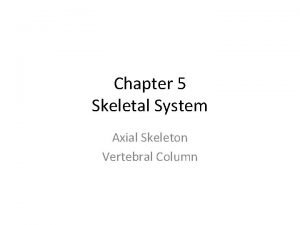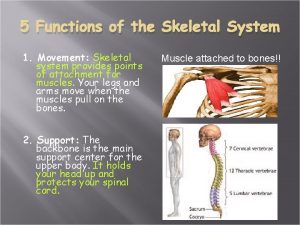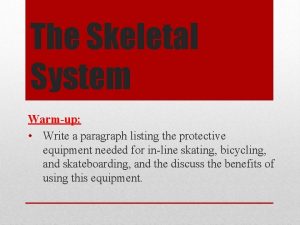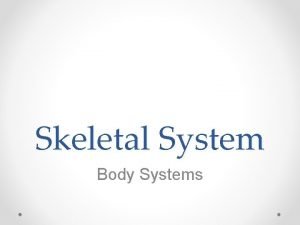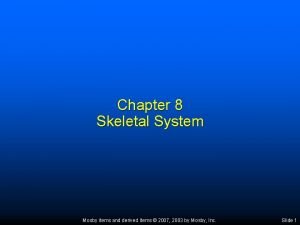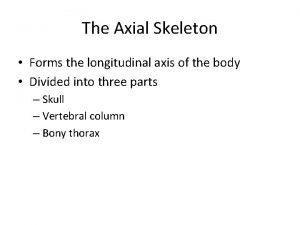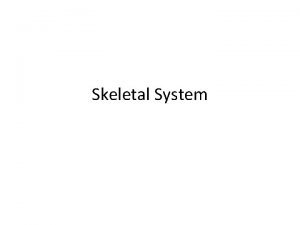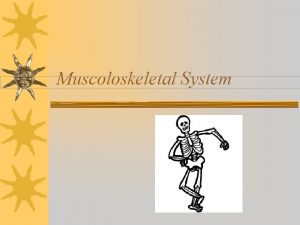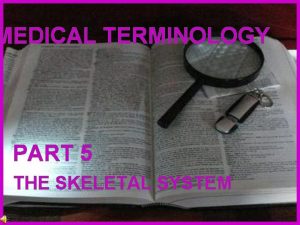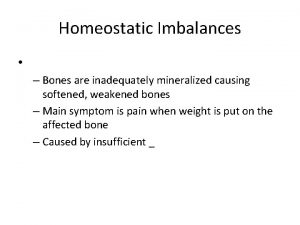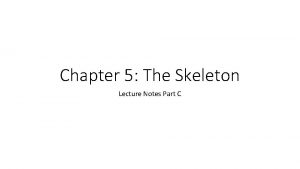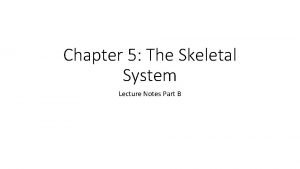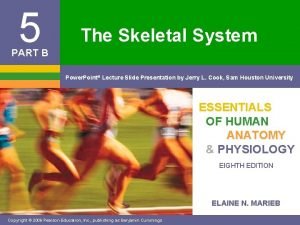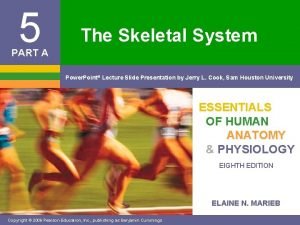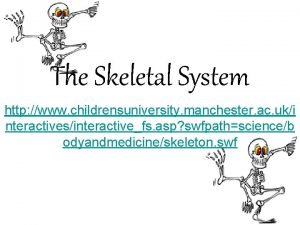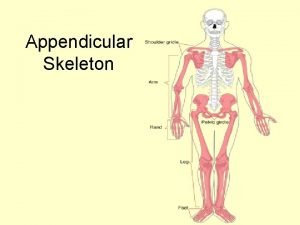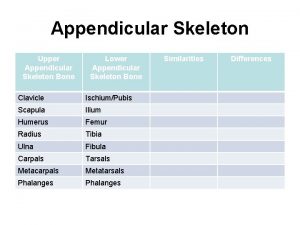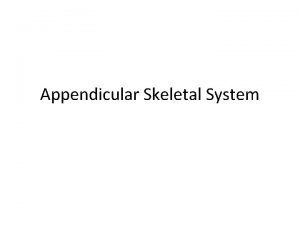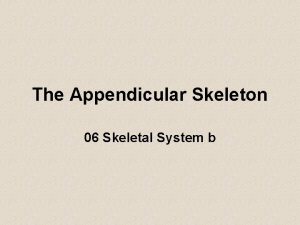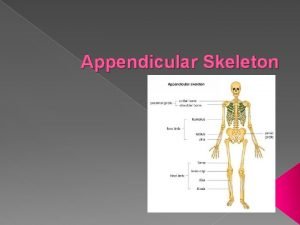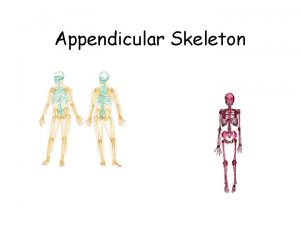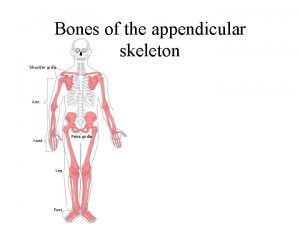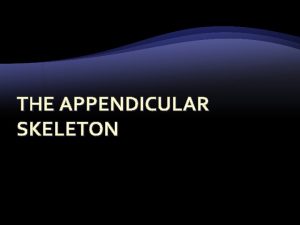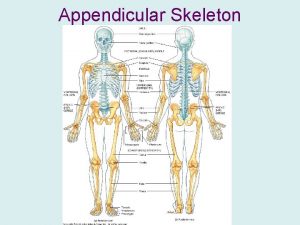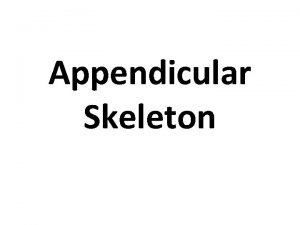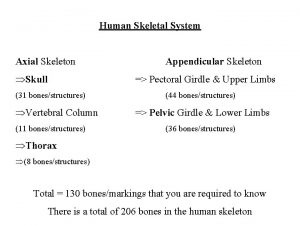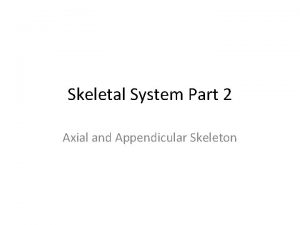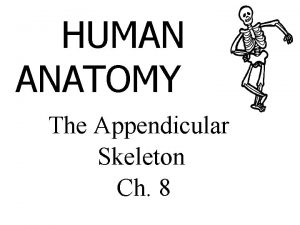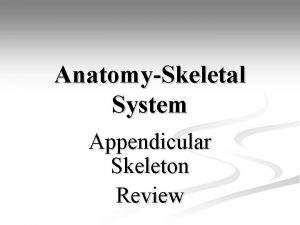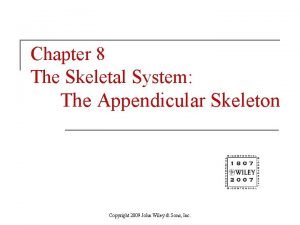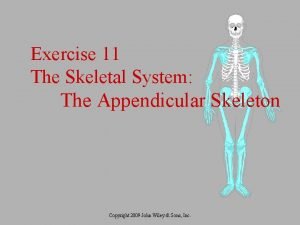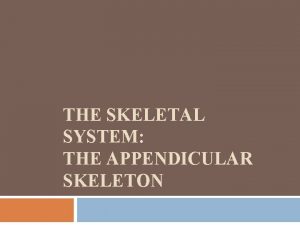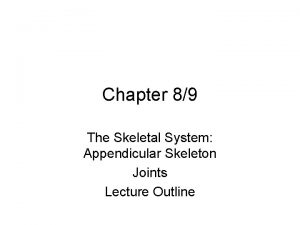The Skeletal System Part 2 The Appendicular Skeleton



























































- Slides: 59

The Skeletal System Part 2 The Appendicular Skeleton Honors Anatomy & Physiology

The Appendicular Skeleton

� 2 pectoral girdles �attach bones of upper limbs to axial skeleton �each: 1 clavicle � 1 scapula The Pectoral Girdle (Shoulder)

�S-shaped, (medial ½ convex anteriorly, lateral ½ concave anteriorly) slender bone �lies horizontally across anterior thorax superior to 1 st rib Clavicle

�medial end = sternal end is rounded & articulates with the manubrium @ sternoclavicular joint Clavicle

�lateral end = acromial end is flat �articulates with acromion of the scapula to form acromialclavicular joint Clavicle

�last bone to stop growing � 1 of most frequently fx’d bones (2 curves) usually from fall on outstretched arm �or see compression fx in auto accidents from shoulder strap which can cause damage to median n. (between clavicle & 2 nd rib) Clavicle

�aka shoulder blade, angel bone �large, triangular, flat bone �in superior part of posterior thorax between levels of 2 nd & 7 th ribs �spine: prominent ridge that runs diagonally across posterior surface Scapula

�lateral edge: acromion a flattened expanded process, easily felt as hi pt of shoulder (tailors use it as landmark to measure length of arm) �glenoid cavity: inferior to acromion, smooth, shallow depression that accepts head of humerus in shoulder joint Scapula

Scapula

� 6 1. 2. 3. 4. 5. 6. parts: Humerus Ulna Radius Carpals Metacarpals Phalanges Upper Limb �Joints: �Shoulder �Elbow �Wrist �Hand

�longest & largest bone of upper limb �articulates proximally with scapula & distally with ulna & radius �head: rounded proximal end �articulates with glenoid cavity of scapula to form glenohumeral joint Humerus

Humerus

�distal end: �capitulum: rounded knob on lateral aspect that articulates with head of radius �trochlea: medial to capitulum, spool-shaped, articulates with ulna Humerus

Humerus

�medial aspect of forearm �longer than radius �proximal end: olecranon (prominence in elbow) �distal end: head, styloid process (posterior) Ulna

�lateral aspect of forearm �proximal end: head of radius: articulates with capitulum �distal end: styloid process (palpable proximal to thumb) Radius

�connect @ 3 places 1. interosseous membrane 2. proximal end 3. distal end Ulna & Radius

�proximal to the hand, distal to radius & ulna � 8 small bones joined by ligaments �articulations w/each other called intercarpal joints Carpals

Carpal Tunnel

Metacarpals

� 14 bones of the digits (each hand) �#’d I to V beginning with thumb �thumb is the pollex has only 2 phalanges, other digits have 3 �joints between phalanges called interphalangeal joints Phalanges

Phalanges


� 2 hip bones (os coxa) which unite anteriorly at pubic symphysis and posteriorly with the sacrum @ sacroiliac joint Pelvic Girdle

�Functions: �provides sturdy support for vertebral column �connects lower limb to axial skeleton Pelvic Girdle

� 3 bones on each side: 1. Ilium ◦ superior Pubis 2. ◦ anterior & inferior Ischium � posterior & inferior 3. Newborn Pelvis

�largest of the 3 hip bones �distinguishing features: 1. Iliac Crest � along superior surface 1. Sacroiliac Joint (SI Joint) � between sacrum and ilium Ilium

Ilium

�ramus of ischium fuses with pubis �distinguishing features: Ischial Tuberosity � what you feel when someone sits on your lap 1. Ischium

Ischium

�Acetabulum ◦ formed by ilium, ischium, & pubis ◦ is the “socket” half of the hip joint �Pubic Symphysis ◦ joint between the 2 hip bones Pubis

�Pelvic Brim: line that distinguishes between true & false palvis True Pelvis/ False Pelvis

�generally male bone heavier & stronger & have larger surface marker (because larger muscles attach) �Pelvis: ◦ deeper false pelvis, smaller, narrower ◦ pelvic brim heart-shaped ◦ acetabulum larger, faces posterior ◦ obturator foramen round Male Pelvis

�generally bones lighter & thinner �Pelvis: ◦ false pelvis shallow, widers ◦ pelvic brim larger, more oval ◦ acetabulum smaller & faces anterior ◦ obturator foramen oval Female Pelvis

Male or Female?

Male or Female?

� 30 bones in each: � 1 femur � 1 patella � 1 tibia � 1 fibula � 7 tarsals � 5 metatarsals � 14 phalanges Lower Limb

�longest, heaviest, & strongest bone in the body �proximally articulates with the acetabulum to form hip joint ◦ Head of the Femur: “ball” part of joint �small, central depression: fovea capitis ◦ Greater Trochanter �prominence felt & seen @ side of hip Femur

Femur

�distally articulates with: ◦ Patella ◦ Tibia Femur

�small, triangular, sesamoid bone �develops in tendon of quadriceps femoris muscle �Parts: �Base: broad, superior end �Apex: pointed, inferior end Patella (kneecap)

Patella


“shin bone” larger, medial, weight-bearing bone of lower leg proximally articulates with femur & fibula distally articulates with fibula & tarsals Tibia

�medial malleolus forms prominence that is palpable & visible on medial ankle Tibia

�parallel & lateral to the tibia & considerably smaller �head of fibula on proximal end �lateral malleolus at distal end Fibula

Tibia & Fibula

� 7 bones: � 1 calcaneous: heel bone, largest of the tarsals Tarsals

� 5 bones between tarsals & phalanges �#’d I to V from medial lateral Metatarsals

� 14 bones that make up the 5 digits �#’d I to V medial to lateral �Hallux: great or big toe has 2 large heavy phalanges Phalanges

� 2 arches in foot: 1. allows the foot to support weight of body by distributing weight over the soft & hard tissues 2. provide leverage while walking fully developed by age 12 - 13 Arches of the Foot

� 2 longitudinal arches (medial & lateral � 1 Arches of the Foot transverse arch


�all skeletal tissue arises from mesoderm � 1 st bone: skull in 4 th wk �U/S ~ 24 – 25 wks: Development of the Skeletal System

Clubfoot: 1. ◦ ◦ ◦ inherited deformity in which baby is born with foot twisted inferiorly & medially 1/1000 births tx: casts or wraps, surgery may be indicated Medical Terminology

2. Genu valgum: � knees abnormally close together with increased space between ankles �aka “knock-knee” Medical Terminology

3. Genu varum: �knees abnormally separated �with lower limbs bowed medially �aka “bowleg” Medical Terminology

 Difference between axial and appendicular skeleton
Difference between axial and appendicular skeleton Axial skeleton vs appendicular
Axial skeleton vs appendicular Lumbocostal triangle
Lumbocostal triangle Innominate bone diagram
Innominate bone diagram Difference between axial and appendicular skeleton
Difference between axial and appendicular skeleton Figure 6-4 the skeleton axial and appendicular divisions
Figure 6-4 the skeleton axial and appendicular divisions Figure 6-2 structure of a typical bone
Figure 6-2 structure of a typical bone Figure 6-4 the skeleton axial and appendicular divisions
Figure 6-4 the skeleton axial and appendicular divisions Posterior view of patella
Posterior view of patella Figure 6-4 the skeleton axial and appendicular divisions
Figure 6-4 the skeleton axial and appendicular divisions Axial skull
Axial skull Anatomy and physiology chapter 8 skeletal system
Anatomy and physiology chapter 8 skeletal system Appendicular skeleton 126 bones
Appendicular skeleton 126 bones The appendicular skeleton consists of
The appendicular skeleton consists of Skeletal system
Skeletal system Chapter 7:4 skeletal system
Chapter 7:4 skeletal system Chapter 7:4 skeletal system label the skeleton
Chapter 7:4 skeletal system label the skeleton Receive
Receive Skeleton steel framing system
Skeleton steel framing system Atd angle full form
Atd angle full form Appendicular muscles arm
Appendicular muscles arm Appendicular muscle
Appendicular muscle Appendicular
Appendicular Appendicular infiltrate
Appendicular infiltrate Five functions of the skeletal system
Five functions of the skeletal system Medical terminology skeletal system
Medical terminology skeletal system Chapter 5 the skeletal system
Chapter 5 the skeletal system Chapter 3 skeletal system kaplan medical answer key
Chapter 3 skeletal system kaplan medical answer key Chapter 5 the skeletal system
Chapter 5 the skeletal system Section 36-1 the skeletal system
Section 36-1 the skeletal system Five functions of the skeletal system
Five functions of the skeletal system Nervous system amusement park
Nervous system amusement park Dem crazy bones labeling
Dem crazy bones labeling 2009 delmar cengage learning
2009 delmar cengage learning Axial skeleton vertebrae
Axial skeleton vertebrae Chapter 32 section 2 the skeletal system answer key
Chapter 32 section 2 the skeletal system answer key Nervous system amusement park
Nervous system amusement park 5 functions skeletal system
5 functions skeletal system Muscle
Muscle How to care for the skeletal system
How to care for the skeletal system Metatarsals definition
Metatarsals definition Whats the main function of the skeletal system
Whats the main function of the skeletal system Chapter 8 skeletal system
Chapter 8 skeletal system Skeletal system
Skeletal system The axial skeleton forms the longitudinal axis of the body
The axial skeleton forms the longitudinal axis of the body Skeletal system bell ringer
Skeletal system bell ringer Muscolo skeletal system
Muscolo skeletal system Skeletal system root words
Skeletal system root words The pectoral girdle consists of the __________.
The pectoral girdle consists of the __________. Chapter 5 the skeletal system figure 5-13
Chapter 5 the skeletal system figure 5-13 Human skull superior view
Human skull superior view Chapter 5 the skeletal system
Chapter 5 the skeletal system Chapter 3 the skeletal system labeling exercises
Chapter 3 the skeletal system labeling exercises Chapter 5 the skeletal system figure 5-13
Chapter 5 the skeletal system figure 5-13 Chapter 5 the skeletal system figure 5-10
Chapter 5 the skeletal system figure 5-10 Skeletal system
Skeletal system Bone marrow
Bone marrow Autonomic nervous system skeletal muscle
Autonomic nervous system skeletal muscle Chapter 8 skeletal system
Chapter 8 skeletal system Learning objectives of skeletal system
Learning objectives of skeletal system

